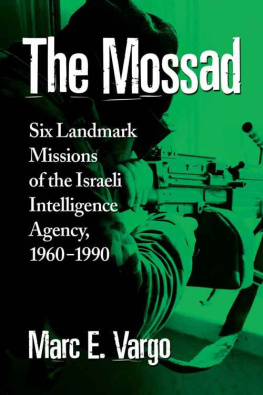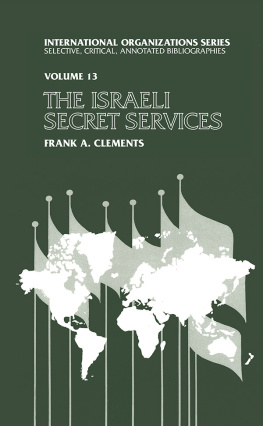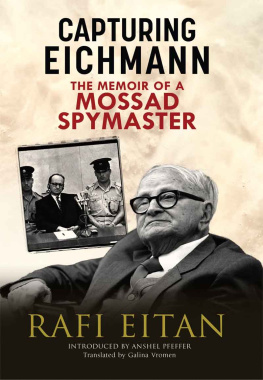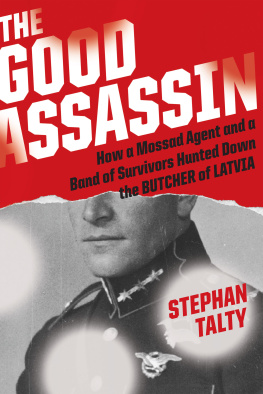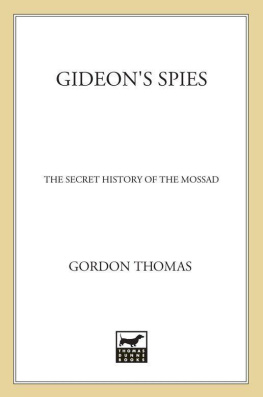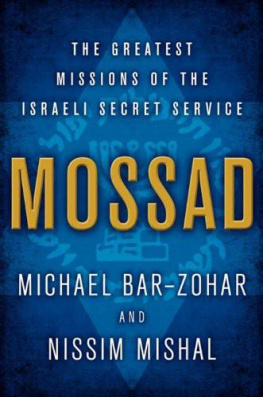Also by MARC E. VARGO
Women of the Resistance: Eight Who Defied the Third Reich (2012)
The Mossad
Six Landmark Missions of the Israeli Intelligence Agency, 19601990
Marc E. Vargo

McFarland & Company, Inc., Publishers
Jefferson, North Carolina
LIBRARY OF CONGRESS CATALOGUING DATA ARE AVAILABLE
BRITISH LIBRARY CATALOGUING DATA ARE AVAILABLE
e-ISBN: 978-1-4766-1966-8
2015 Marc E. Vargo. All rights reserved
No part of this book may be reproduced or transmitted in any form or by any means, electronic or mechanical, including photocopying or recording, or by any information storage and retrieval system, without permission in writing from the publisher.
Cover image Dreamstime.com
McFarland & Company, Inc., Publishers
Box 611, Jefferson, North Carolina 28640
www.mcfarlandpub.com
For Addison Vargo,
With a wish for a wiser and more peaceful world.
Covert action should not be confused with missionary work.
Henry Kissinger, 1975
Table of Contents
Introduction
Among the worlds most formidable intelligence agencies is the Mossad, the organization that David Ben-Gurion, the first prime minister of Israel, established on December 13, 1949. An inspired concept, the Mossad was designed to enhance the ability of Israels intelligence community to gather information that would help protect the nation from attack, most notably invasion by its Arab neighbors. Certainly it was no secret that the Jewish state was in need of a smart, hard-nosed bureau of this type, national security being a paramount concern since the creation of the state of Israel.
It was on May 14, 1948, that the Jewish people celebrated the birth of their new home, the end result of a controversial resolution adopted by the United Nations General Assembly. Yet the pride and grandeur of the occasion, the profound exultation of a newborn nation, was not to last. Within hours, the surrounding Arab nations greeted their young neighbor not with a handshake but with hostility, their militaries laying siege to the fledgling republic by land and sea. And these were not mere skirmishes, isolated and insignificant, designed to dampen the public spirit. Rather, the invaders, all of them charter members of the League of Arab States, were seeking to eradicate the Jewish domain before it had a chance to fully establish itself. To ensure a victory, moreover, the assailants boosted the number and reach of their sorties as the hours passed.
Throughout the second full day of Israels independence, writes historian Martin Gilbert, Lebanese troops were advancing from the north; Syrian, Iraqi and Transjordanian troops from the east; Egyptian troops from the south. Yet Israel was not without hope, its military being equal to the challenge.
Boasting nearly thirty-seven thousand troops, the Israeli armed forces counted among their fighters scores of former members of the Haganah, the Jewish paramilitary organization. Then, too, the countrys military strategists, a collection of shrewd tacticians, had anticipated the Arab offensive. So it was that the Israelis, their new nations survival in the balance, fought brilliantly, driving back the assailants and preserving their countrys sovereignty. In so doing, they earned the worlds admiration, even the begrudging respect of their opponents. However, the latters regard applied only to the skills of the Israeli military; it did not extend to reassessing, and accepting, the Jewish states right to possess the land that the United Nations had placed in its possession. It was for this reason that Ben-Gurion, convinced that more attacks were on the horizon, set about assembling a national intelligence apparatus to maintain a watch on the region. His aim was to monitor all potential sources of threatforeign and domestic, military and armed civilianso that Israel could be forewarned about impending terrorist attacks and military strikes.
In Ben-Gurions initial setup, Israels intelligence system was designed to consist of five distinct yet interrelated components, each of which would perform its specific functions while collaborating with the other four units. But while the idea of a well-integrated intelligence community appeared feasible on paper, complications arose when it was put into practice, a situation that was due largely to the ambiguity of the units boundaries and functions. There was neither an absolute definition of responsibility nor a clear set of guidelines for action, writes Dennis Eisenberg. Positioned in such a way as to transcend the malfunctioning machinery of the existent intelligence community, the new agency would nevertheless make use of the apparatus five components, absorbing a portion of their responsibilities, conscripting members of their staffs, and conferring with their directors.
As to its formal purpose, the Mossad was to have two additional duties on top of coordinating the other intelligence units. First, it was to gather and analyze information abroad, writes Eisenberg, in any area that might be of interest to Israel. Sensitive material pertaining to the surrounding Arab states was, of course, to be given precedence. And second, the organization was to conduct special operations at the behest of the prime minister, the character of such projects, by virtue of their covert nature, being undefined in the agencys mandate.
A restructuring of the intelligence community on March 2, 1951, led to the Mossad being placed directly under the prime minister. Whereas it initially had been answerable to the foreign minister, its subsequent standing within the governmental hierarchy rendered it a freer, more flexible entity. In the same stroke, the agencys privileged position invited envy from certain quarters, along with tall expectations. The Mossad rose to the occasion, however. Sidestepping the internecine jealousies, it performed its duties with cool efficiency, thereby fulfilling the hopes that had been placed upon it.
In the course of the 1950s, the agency, under the guidance of Isser Harel, cultivated an impressive number of well-placed sources within the Arab world, in this way collecting information that could help prevent Israels destruction. Alongside these efforts, the Mossad courted Western nations that were in a position to help ensure Israels survival. Of these overtures, arguably the most productive occurred in 1954 when Harel traveled to Washington, D.C., to forge an alliance with Alan Dulles, the director of the Central Intelligence Agency. For Israel, the relationship proved to be a game-changer. Dulles arranged for Mossad to have state-of-the-art equipment, writes Gordon Thomas, listening and tracking devices, remote-operated cameras, and a range of gadgets that Harel admitted he never knew existed.
During the ensuing years, the Mossad made use of this innovative technology to enhance its surveillance of its adversaries. And these foes were formidable by any standard. The preponderance, as noted earlier, was comprised of neighboring Arab forces bent on putting an end to the State of Israel, the principal argument being that the United Nations had awarded it a disproportionate amount of territory. But Israels enemies also included several German scientistsrabid and unrepentant Nazis, in the words of Zvi Malkinwho, after World War II, agreed to help certain Arab states advance their weapons programs.
The Israeli government, for its part, was troubled by the participation of the German scientists, and justifiably so; their technical expertise coupled with their willingness to work for the Arab cause did not bode well for the beleaguered republic. Accordingly, Harel ordered his Mossad staff to monitor their activities. As the German scientists involvement became even more worrisome in the ensuing years, however, he decided that his agents should do more than merely observe the situation; they should undercut the Germans contributions to Egypts burgeoning missile program. And his agents did so in a singularly sinister style. [T]he Mossad, writes Ian Black, waged a ruthless secret war of threats and assassinations against German scientists building rockets in Nassers Egypt.
Next page
